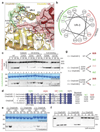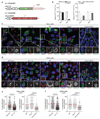A Chlamydia effector combining deubiquitination and acetylation activities induces Golgi fragmentation
- PMID: 30397340
- PMCID: PMC6319605
- DOI: 10.1038/s41564-018-0271-y
A Chlamydia effector combining deubiquitination and acetylation activities induces Golgi fragmentation
Abstract
Pathogenic bacteria are armed with potent effector proteins that subvert host signalling processes during infection1. The activities of bacterial effectors and their associated roles within the host cell are often poorly understood, particularly for Chlamydia trachomatis2, a World Health Organization designated neglected disease pathogen. We identify and explain remarkable dual Lys63-deubiquitinase (DUB) and Lys-acetyltransferase activities in the Chlamydia effector ChlaDUB1. Crystal structures capturing intermediate stages of each reaction reveal how the same catalytic centre of ChlaDUB1 can facilitate such distinct processes, and enable the generation of mutations that uncouple the two activities. Targeted Chlamydia mutant strains allow us to link the DUB activity of ChlaDUB1 and the related, dedicated DUB ChlaDUB2 to fragmentation of the host Golgi apparatus, a key process in Chlamydia infection for which effectors have remained elusive. Our work illustrates the incredible versatility of bacterial effector proteins, and provides important insights towards understanding Chlamydia pathogenesis.
Conflict of interest statement
The authors declare no competing interests.
Figures




Similar articles
-
The Two Deubiquitinating Enzymes from Chlamydia trachomatis Have Distinct Ubiquitin Recognition Properties.Biochemistry. 2020 Apr 28;59(16):1604-1617. doi: 10.1021/acs.biochem.9b01107. Epub 2020 Apr 14. Biochemistry. 2020. PMID: 32275137 Free PMC article.
-
CteG is a Chlamydia trachomatis effector protein that associates with the Golgi complex of infected host cells.Sci Rep. 2019 Apr 16;9(1):6133. doi: 10.1038/s41598-019-42647-3. Sci Rep. 2019. PMID: 30992493 Free PMC article.
-
Chlamydia Hijacks ARF GTPases To Coordinate Microtubule Posttranslational Modifications and Golgi Complex Positioning.mBio. 2017 May 2;8(3):e02280-16. doi: 10.1128/mBio.02280-16. mBio. 2017. PMID: 28465429 Free PMC article.
-
[Effector proteins of Clamidia].Mol Biol (Mosk). 2009 Nov-Dec;43(6):963-83. Mol Biol (Mosk). 2009. PMID: 20088373 Review. Russian.
-
Conserved type III secretion system exerts important roles in Chlamydia trachomatis.Int J Clin Exp Pathol. 2014 Aug 15;7(9):5404-14. eCollection 2014. Int J Clin Exp Pathol. 2014. PMID: 25337183 Free PMC article. Review.
Cited by
-
Correlating Predicted Reactivities with Experimental Inhibition Data of Covalent ChlaDUB1 Inhibitors.ACS Med Chem Lett. 2024 Sep 10;15(10):1708-1714. doi: 10.1021/acsmedchemlett.4c00267. eCollection 2024 Oct 10. ACS Med Chem Lett. 2024. PMID: 39411534
-
An endometrial organoid model of interactions between Chlamydia and epithelial and immune cells.J Cell Sci. 2021 Mar 8;134(5):jcs252403. doi: 10.1242/jcs.252403. J Cell Sci. 2021. PMID: 33468625 Free PMC article.
-
The role of the Golgi apparatus in disease (Review).Int J Mol Med. 2021 Apr;47(4):38. doi: 10.3892/ijmm.2021.4871. Epub 2021 Feb 4. Int J Mol Med. 2021. PMID: 33537825 Free PMC article. Review.
-
Detection of Chlamydia Developmental Forms and Secreted Effectors by Expansion Microscopy.Front Cell Infect Microbiol. 2019 Aug 9;9:276. doi: 10.3389/fcimb.2019.00276. eCollection 2019. Front Cell Infect Microbiol. 2019. PMID: 31448242 Free PMC article.
-
Crystal Structure of African Swine Fever Virus pS273R Protease and Implications for Inhibitor Design.J Virol. 2020 May 4;94(10):e02125-19. doi: 10.1128/JVI.02125-19. Print 2020 May 4. J Virol. 2020. PMID: 32075933 Free PMC article.
References
-
- Misaghi S, et al. Chlamydia trachomatis-derived deubiquitinating enzymes in mammalian cells during infection. Mol Microbiol. 2006;61:142–150. - PubMed
Publication types
MeSH terms
Substances
Grants and funding
LinkOut - more resources
Full Text Sources
Medical

